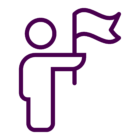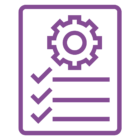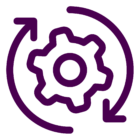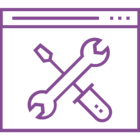Organizations in the 21st century face great opportunities and threats presented by fast paced technological advances. According to Forbes Magazine, the most defining traits of a successful 21st century organization are:
- Relentless innovation, which requires a new mindset that liberates everyone in the organization to innovate regardless of position or function; and
- Breakthrough performance environments that are flexible enough to support rapid movement, speedy decision-making, and process alignment to regularly achieve competitive outcomes.
When long-rooted processes start to fail and the need for such lean delivery becomes more evident, change becomes a question of when and focused on how to realize the desired results with just the right amount of disruption.
So, how can managers in existing roles translate respective skill sets to develop and grow an agile organization? If you are part of a change initiative or would like to spearhead this challenging, yet promising journey of organizational change, below are effective ways to practice Agile in your respective role.
1. Program & Project Management
The agile mindset requires the shift for program / project managers from the functions of monitoring and controlling to a focus on guiding purpose and vision. Below are specific areas that create the opportunities for program managers to facilitate Agile practices.

Leading Vision and Milestones: Program Managers can highlight and utilize leadership skills to drive high-level strategies, develop project / product roadmaps and set priorities based on long-term vision and business objectives. As Program Managers shift their skills, they are better able to focus on their management functions like effective goal setting, design and development of working environments, management of risk and dependencies across teams, and the removal of impediments.

Managing Portfolios Through Short Delivery Cycles: Program Managers can leverage their portfolio management and governance skill sets to reinforce agile values by creating frequent portfolio planning and delivery cycles (quarterly is recommended), setting goals on a rolling basis, and facilitating an environment to make frequent decisions regarding which projects to stop, start, or continue. Additionally, program managers can develop their lean skills in creating value stream analysis and defining minimum viable product development (MVP) to achieve a deeper understanding of customer needs early and acquire frequent feedback to maximize product delivery.

Leveraging PMO Functions: Because the program management function is shared and/or distributed across the organization and multiple teams, an agile Project Management Office (PMO) can leverage its processes and governance role to facilitate agility and faster response. For instance, the requirements management function for project managers can move to Product Owners while the task / work assignments will be self-assigned by self-organizing teams. This will provide project managers focus to lead project objectives, milestones, strategy, finances, risk, change management and enabling resources for their teams. Further, applying management skills in tandem with Agile planning, executing, monitoring and communications approaches provides managers the required tools to continually evaluate project health, reward, coach, nurture, and remove cultural / resource impediments.
2. Functional Management
The skill sets required of Functional Managers in Agile shifts from thinking tactical to strategic. As part of this shift, functional managers can employ the following important skill sets and play an integral role in enabling Agile environments.

Subject Matter Expertise: Functional managers can serve as Technical or Business Leads or Subject Matter Experts, advising the team via the product/project leadership, enhancing the value of their function in light of the overall vision and by communicating the business need. This means focusing on setting a clear vision, defining acceptance criteria and letting the team figure out the ‘how’ by providing guidance and direction when needed.
Process Improvement: Proximity of Functional/Middle Managers to employees and their close understanding of team dynamics enables initiatives usually instigated by middle manager to win greater employee support (rather than top management). To this end, functional managers can shift from hands-on “doing” during Agile transformations to guiding behavioral changes through coaching and creating the platform for developing knowledge and working standards. This further enables Functional Managers to support Agile facilitators such as, Scrum Masters by responding to resource needs, removing impediments, and eliminating departmental siloes and dependencies.
3. Technical Management
The Agile technical design and development approach shifts the notion of a single person being in charge of design. Instead, the responsibility is shared by the entire technical team, where the design and development processes are intertwined.

Systems Design: Architectural designers can leverage their technical skills on developing the high-level system design and strategy, a roadmap for the desired system state, while continuing to guide the development team on the architecture that is to be created during the coding process.

Technical Standards and Requirements: In terms of technical design requirements, technical managers can successfully evolve into the role of technical product owners in order to guide technical excellence and prioritize technical strategy throughout the development process. This position requires a unique skill set where the technical Product Owner offers knowledge and can provide strategic roadmapping for products that require an understanding of the organizational technical landscape.
Closing
Successful Agile organizations possess the ability to mature from top-down command-and-control to bridging the gap for self-organizing teams, and from siloed communication to cross-functional collaboration that enables direct and ongoing feedback and improvement across the organization. If you are looking to instill an “Agile way of working” within your team or program, you can learn more about our proven approaches on how to harness your skills to drive Agility or contact us so we can help you deliver successful initiatives and mature towards continuous improvement.
